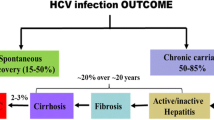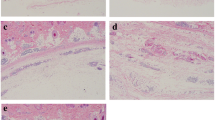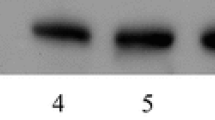Abstract
The presence of neutralising antibodies (NAbs) against adenovirus in the population is a major hurdle preventing the effective use of replication-defective adenoviruses (Ads) as candidates for gene therapy and vaccine vectors for many diseases. Only a few studies have described the epidemiology of pre-existing immunity to chimpanzee Ads in China. To assess the prevalence of NAbs to chimpanzee adenovirus serotypes 6 and 7 (AdC6 and AdC7), we enrolled 998 healthy participants from five regions in China as well as 196 chronic hepatitis B virus (HBV) patients and 193 primary hepatocellular carcinoma (HCC) patients from Chongqing, China. The total seroprevalence rates of AdC6 and AdC7 NAbs in the healthy participants were 12.22 % (122/998) (95 % confidence interval [CI], 10.34-14.40 %) and 13.13 % (131/998) (95 % CI, 11.17-15.36 %), respectively. The seroprevalence rates of AdC6 and AdC7 NAbs in the HBV patients were 21.43 % (42/196) (95 % CI, 16.26-27.69 %) and 25.51 % (50/196) (95 % CI, 19.92-32.04 %), respectively. The seroprevalence rates of AdC6 and AdC7 NAbs in the HCC patients were 27.46 % (53/193) (95 % CI, 21.65-34.15 %) and 31.09 % (60/193) (95 % CI, 24.98-37.93 %), respectively. The seroprevalence rates of these Ads were not associated with age and gender. The present study may provide useful insights for developing future AdC-based vaccines and gene therapies.


Similar content being viewed by others
References
Farina SF, Gao GP, Xiang ZQ, Rux JJ, Burnett RM, Alvira MR, Marsh J, Ertl HC, Wilson JM (2001) Replication-defective vector based on a chimpanzee adenovirus. J Virol 75:11603–11613
Kozarsky KF, Wilson JM (1993) Gene therapy: adenovirus vectors. Curr Opin Genet Dev 3:499–503
Hitt MM, Gauldie J (2000) Gene vectors for cytokine expression in vivo. Curr Pharm Des 6:613–632
Kay MA, Liu D, Hoogerbrugge PM (1997) Gene therapy. Proc Natl Acad Sci USA 94:12744–12746
Xiang ZQ, Yang Y, Wilson JM, Ertl HC (1996) A replication-defective human adenovirus recombinant serves as a highly efficacious vaccine carrier. Virology 219:220–227
Molnar-Kimber KL, Sterman DH, Chang M, Kang EH, ElBash M, Lanuti M, Elshami A, Gelfand K, Wilson JM, Kaiser LR, Albelda SM (1998) Impact of preexisting and induced humoral and cellular immune responses in an adenovirus-based gene therapy phase I clinical trial for localized mesothelioma. Hum Gene Ther 9:2121–2133
Douglas JT (2007) Adenoviral vectors for gene therapy. Mol Biotechnol 36:71–80
Fitzgerald JC, Gao GP, Reyes-Sandoval A, Pavlakis GN, Xiang ZQ, Wlazlo AP, Giles-Davis W, Wilson JM, Ertl HC (2003) A simian replication-defective adenoviral recombinant vaccine to HIV-1 gag. J Immunol 170:1416–1422
Liu J, O’Brien KL, Lynch DM, Simmons NL, La Porte A, Riggs AM, Abbink P, Coffey RT, Grandpre LE, Seaman MS, Landucci G, Forthal DN, Montefiori DC, Carville A, Mansfield KG, Havenga MJ, Pau MG, Goudsmit J, Barouch DH (2009) Immune control of an SIV challenge by a T-cell-based vaccine in rhesus monkeys. Nature 457:87–91
O’Brien KL, Liu J, King SL, Sun YH, Schmitz JE, Lifton MA, Hutnick NA, Betts MR, Dubey SA, Goudsmit J, Shiver JW, Robertson MN, Casimiro DR, Barouch DH (2009) Adenovirus-specific immunity after immunization with an Ad5 HIV-1 vaccine candidate in humans. Nat Med 15:873–875
Piedra PA, Poveda GA, Ramsey B, McCoy K, Hiatt PW (1998) Incidence and prevalence of neutralizing antibodies to the common adenoviruses in children with cystic fibrosis: implication for gene therapy with adenovirus vectors. Pediatrics 101:1013–1019
Radosevic K, Wieland CW, Rodriguez A, Weverling GJ, Mintardjo R, Gillissen G, Vogels R, Skeiky YA, Hone DM, Sadoff JC, van der Poll T, Havenga M, Goudsmit J (2007) Protective immune responses to a recombinant adenovirus type 35 tuberculosis vaccine in two mouse strains: CD4 and CD8 T-cell epitope mapping and role of gamma interferon. Infect Immun 75:4105–4115
Sun C, Zhang L, Zhang M, Liu Y, Zhong M, Ma X, Chen L (2010) Induction of balance and breadth in the immune response is beneficial for the control of SIVmac239 replication in rhesus monkeys. J Infect 60:371–381
Rux JJ, Kuser PR, Burnett RM (2003) Structural and phylogenetic analysis of adenovirus hexons by use of high-resolution x-ray crystallographic, molecular modeling, and sequence-based methods. J Virol 77:9553–9566
Davis AR, Wivel NA, Palladino JL, Tao L, Wilson JM (2001) Construction of adenoviral vectors. Mol Biotechnol 18:63–70
Ersching J, Hernandez MI, Cezarotto FS, Ferreira JD, Martins AB, Switzer WM, Xiang Z, Ertl HC, Zanetti CR, Pinto AR (2010) Neutralizing antibodies to human and simian adenoviruses in humans and New-World monkeys. Virology 407:1–6
Abbink P, Lemckert AA, Ewald BA, Lynch DM, Denholtz M, Smits S, Holterman L, Damen I, Vogels R, Thorner AR, O’Brien KL, Carville A, Mansfield KG, Goudsmit J, Havenga MJ, Barouch DH (2007) Comparative seroprevalence and immunogenicity of six rare serotype recombinant adenovirus vaccine vectors from subgroups B and D. J Virol 81:4654–4663
Holterman L, Vogels R, van der Vlugt R, Sieuwerts M, Grimbergen J, Kaspers J, Geelen E, van der Helm E, Lemckert A, Gillissen G, Verhaagh S, Custers J, Zuijdgeest D, Berkhout B, Bakker M, Quax P, Goudsmit J, Havenga M (2004) Novel replication-incompetent vector derived from adenovirus type 11 (Ad11) for vaccination and gene therapy: low seroprevalence and non-cross-reactivity with Ad5. J Virol 78:13207–13215
Appaiahgari MB, Pandey RM, Vrati S (2007) Seroprevalence of neutralizing antibodies to adenovirus type 5 among children in India: implications for recombinant adenovirus-based vaccines. Clin Vaccine Immunol 14:1053–1055
Sun C, Zhang Y, Feng L, Pan W, Zhang M, Hong Z, Ma X, Chen X, Chen L (2011) Epidemiology of adenovirus type 5 neutralizing antibodies in healthy people and AIDS patients in Guangzhou, southern China. Vaccine 29:3837–3841
Hensley SE, Cun AS, Giles-Davis W, Li Y, Xiang Z, Lasaro MO, Williams BR, Silverman RH, Ertl HC (2007) Type I interferon inhibits antibody responses induced by a chimpanzee adenovirus vector. Mol Ther 15:393–403
Wevers D, Metzger S, Babweteera F, Bieberbach M, Boesch C, Cameron K, Couacy-Hymann E, Cranfield M, Gray M, Harris LA, Head J, Jeffery K, Knauf S, Lankester F, Leendertz SA, Lonsdorf E, Mugisha L, Nitsche A, Reed P, Robbins M, Travis DA, Zommers Z, Leendertz FH, Ehlers B (2011) Novel adenoviruses in wild primates: a high level of genetic diversity and evidence of zoonotic transmissions. J Virol 85:10774–10784
Capone S, Meola A, Ercole BB, Vitelli A, Pezzanera M, Ruggeri L, Davies ME, Tafi R, Santini C, Luzzago A, Fu TM, Bett A, Colloca S, Cortese R, Nicosia A, Folgori A (2006) A novel adenovirus type 6 (Ad6)-based hepatitis C virus vector that overcomes preexisting anti-ad5 immunity and induces potent and broad cellular immune responses in rhesus macaques. J Virol 80:1688–1699
Lemckert AA, Grimbergen J, Smits S, Hartkoorn E, Holterman L, Berkhout B, Barouch DH, Vogels R, Quax P, Goudsmit J, Havenga MJ (2006) Generation of a novel replication-incompetent adenoviral vector derived from human adenovirus type 49: manufacture on PER.C6 cells, tropism and immunogenicity. J Gen Virol 87:2891–2899
Xiang Z, Li Y, Cun A, Yang W, Ellenberg S, Switzer WM, Kalish ML, Ertl HC (2006) Chimpanzee adenovirus antibodies in humans, sub-Saharan Africa. Emerg Infect Dis 12:1596–1599
Chen H, Xiang ZQ, Li Y, Kurupati RK, Jia B, Bian A, Zhou DM, Hutnick N, Yuan S, Gray C, Serwanga J, Auma B, Kaleebu P, Zhou X, Betts MR, Ertl HC (2010) Adenovirus-based vaccines: comparison of vectors from three species of adenoviridae. J Virol 84:10522–10532
Zhang S, Huang W, Zhou X, Zhao Q, Wang Q, Jia B (2013) Seroprevalence of neutralizing antibodies to human adenoviruses type-5 and type-26 and chimpanzee adenovirus type-68 in healthy Chinese adults. J Med Virol 85:1077–1084
Thorner AR, Lemckert AA, Goudsmit J, Lynch DM, Ewald BA, Denholtz M, Havenga MJ, Barouch DH (2006) Immunogenicity of heterologous recombinant adenovirus prime-boost vaccine regimens is enhanced by circumventing vector cross-reactivity. J Virol 80:12009–12016
Tatsis N, Tesema L, Robinson ER, Giles-Davis W, McCoy K, Gao GP, Wilson JM, Ertl HC (2006) Chimpanzee-origin adenovirus vectors as vaccine carriers. Gene Ther 13:421–429
Calcedo R, Vandenberghe LH, Gao G, Lin J, Wilson JM (2009) Worldwide epidemiology of neutralizing antibodies to adeno-associated viruses. J Infect Dis 199:381–390
Halbert CL, Miller AD, McNamara S, Emerson J, Gibson RL, Ramsey B, Aitken ML (2006) Prevalence of neutralizing antibodies against adeno-associated virus (AAV) types 2, 5, and 6 in cystic fibrosis and normal populations: Implications for gene therapy using AAV vectors. Hum Gene Ther 17:440–447
Broderick MP, Hansen CJ, Irvine M, Metzgar D, Campbell K, Baker C, Russell KL (2010) Adenovirus 36 seropositivity is strongly associated with race and gender, but not obesity, among US military personnel. Int J Obes (Lond) 34:302–308
Acknowledgments
We gratefully acknowledge Dr. Hildegund C. J. Ertl at the Wistar Institute, Philadelphia, Pennsylvania, United States, for the reagents, generous advice, and assistance provided. We also gratefully acknowledge Professor Zhihua Tao, Wenzhou Medical College, China, for his help with the serum sample collection.
Conflict of interest
The authors declare no conflicts of interest.
Author information
Authors and Affiliations
Corresponding author
Additional information
L. Jian and Q. Zhao are contributed equally to this work
Rights and permissions
About this article
Cite this article
Jian, L., Zhao, Q., Zhang, S. et al. The prevalence of neutralising antibodies to chimpanzee adenovirus type 6 and type 7 in healthy adult volunteers, patients with chronic hepatitis B and patients with primary hepatocellular carcinoma in China. Arch Virol 159, 465–470 (2014). https://doi.org/10.1007/s00705-013-1828-y
Received:
Accepted:
Published:
Issue Date:
DOI: https://doi.org/10.1007/s00705-013-1828-y




